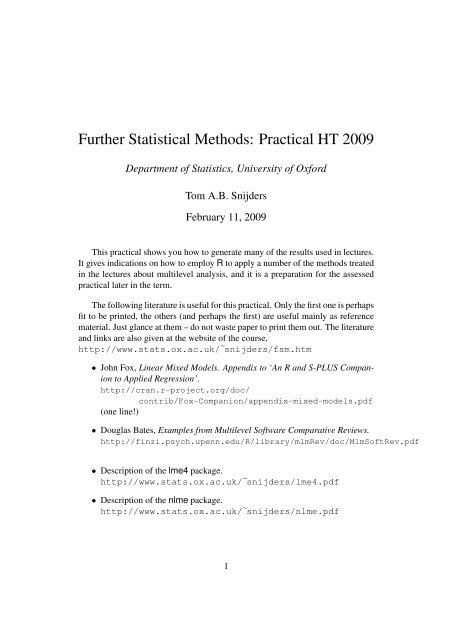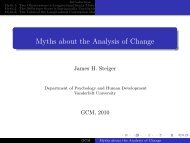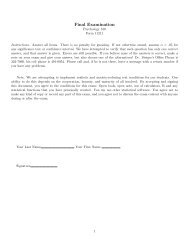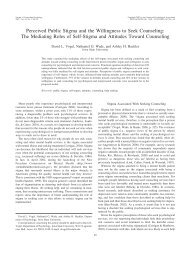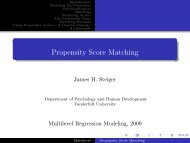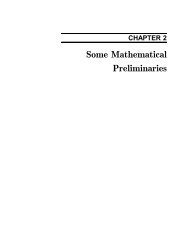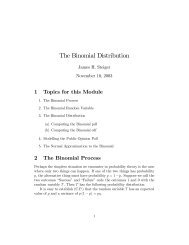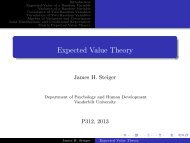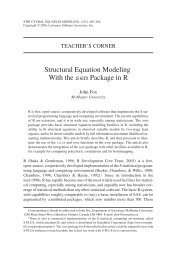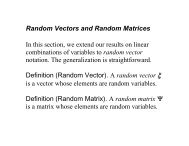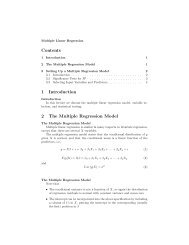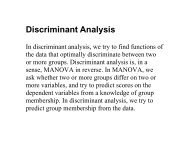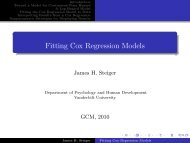Snijders Handout (S&B Ch04 Data) - Statpower
Snijders Handout (S&B Ch04 Data) - Statpower
Snijders Handout (S&B Ch04 Data) - Statpower
- No tags were found...
Create successful ePaper yourself
Turn your PDF publications into a flip-book with our unique Google optimized e-Paper software.
Further Statistical Methods: Practical HT 2009Department of Statistics, University of OxfordTom A.B. <strong>Snijders</strong>February 11, 2009This practical shows you how to generate many of the results used in lectures.It gives indications on how to employ R to apply a number of the methods treatedin the lectures about multilevel analysis, and it is a preparation for the assessedpractical later in the term.The following literature is useful for this practical. Only the first one is perhapsfit to be printed, the others (and perhaps the first) are useful mainly as referencematerial. Just glance at them – do not waste paper to print them out. The literatureand links are also given at the website of the course,http://www.stats.ox.ac.uk/˜snijders/fsm.htm• John Fox, Linear Mixed Models. Appendix to ‘An R and S-PLUS Companionto Applied Regression’.http://cran.r-project.org/doc/contrib/Fox-Companion/appendix-mixed-models.pdf(one line!)• Douglas Bates, Examples from Multilevel Software Comparative Reviews.http://finzi.psych.upenn.edu/R/library/mlmRev/doc/MlmSoftRev.pdf• Description of the lme4 package.http://www.stats.ox.ac.uk/˜snijders/lme4.pdf• Description of the nlme package.http://www.stats.ox.ac.uk/˜snijders/nlme.pdf1
1 <strong>Data</strong> explorationThis session will show you how to fit multilevel models using the nlme and lme4packages of R. 1 It may be noted that the nlme package is more extensive, anddocumented in Pinheiro and Bates (2000). However, lme4 is the more recentpackage and is expected to be extended further.The data set is the data used in <strong>Snijders</strong> & Bosker (1999) which was used alsoin the lectures. It is available in Stata format, and can be imported into R asfollows:library(foreign)mlbook
The data frames schdata and schoolsb are intermediate data frames used forstoring the school means, which are then added to the mlbook data frame. Lookup the definition of tapply to understand what this function does. Have a lookat the data produced and understand the interpretation of the variables meanlp,meaniq, and meanses.What is the total number of pupils in the data set (length of the vector ‘schoolnr’)and what is the total number of schools (length of the vector ‘school’)?To have an exploratory look at the data, we take a sample of 25 schools anddefine a grouped data set. (It is possible also to use all schools but then thesheer number of plots-per-school becomes too large.) To understand the functiongrouped<strong>Data</strong>, look up this command in the description of the nlme library(which is available at the website of the course).library(lattice)library(nlme)samp25
print(model1
2.2 Random slope modelsThe random slope model of Table 5.1 can be fitted byprint(model3
2.3 Model checking with nlmePackage nlme still has more model checking capacities than lme4. Therefore wecontinue with the earlier package. If this gives any problems, it may be best toexit R and then start a session again where you load only nlme as a library andnot lme4.Take care that the variables iqdev and meanIQ are available again. Fittingand comparing mixed models in nlme is done by the lme function as follows.summary(model1n
where the mark=fixef(model2n) parameter requests a line at the fixed effect estimatesof the mixed model. The plots are a bit too crowded, with 131 schools, butit is clearly visible that the OLS estimates are much more variable than the mixedmodel estimates. If this were desired, a smaller part of the data could be obtainedby taking a sample as above and then using only the data specified bydata = mlbook[is.element(schoolnr, samp25), ]This will, however, not be pursued here.The within-group OLS residuals can be obtained now by the commandresi2
3 And finally....It is important to be able communicate results of a statistical analysis to an audiencethat does not primarily have a statistical interest. A final question of theassessed practical will be as follows.“Write a summary, with a maximum length of one page, of your substantive conclusionsof the whole data analysis in a non-technical way that is understandableto persons who know nothing about multilevel analysis.”Try to write such a conclusion for the analysis you have completed now. You candiscuss with a friend who is not a statistician about your text, and try to write it insuch a way that your friend indeed understands some of it!Another aspect of reporting is to present a good table with estimates and standarderrors. The tables given in the handouts are a bit extensive. Look in the paperby Levels, Dronkers, and Kraaykamp (2008) (see course website) for a moreapplication-oriented way of presenting the results in tables.9


